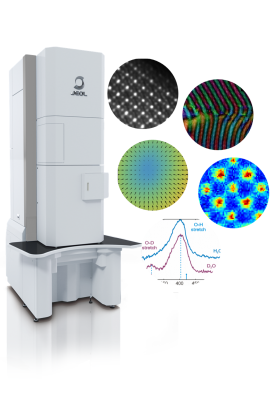$4M NSF award brings next-generation microscope to UIC
Nanoscale materials represent a class of substances that approach the size of individual atoms, about 0.1 to 10 nanometers, in at least one dimension. These materials exhibit properties that are unique from larger scale substances, and they are essential to advancing a wide array of technologies, from magnetic data-storage systems to superconducting quantum computers to biomaterials and biomedical applications.

To study and use these materials, tools are required to examine them at the atomic level while minimizing any disturbance to their structure. Electron microscopy, which uses electron beams to “see” atoms, is one of the fundamental means by which the structures of nanoscale materials can be studied.
Current designs of high-resolution transmission electron microscopes require a lens to focus an electron beam on the specimen surface, said University of Illinois Chicago physicist Robert Klie.
“A side effect of this design is that the sample material is inadvertently exposed to a high magnetic field, so turning the lens off to eliminate the magnetic field when studying magnetic or superconducting materials makes atomic-resolution analysis impossible,” he said.
UIC researchers will soon have a new tool built to overcome the side effect.
Through an $4 million National Science Foundation grant, UIC will be home to the world’s first analytical, aberration-corrected and monochromated transmission electron microscope with a magnetic field-free objective lens. UIC, through the Office of the Vice Chancellor for Research, will contribute the required cost-share of 30%, or $1.7 million, toward the total instrument cost. OVCR will also contribute nearly $4M to renovate space in the Center for Structural Biology not only to house this microscope, but to refresh some of their other shared research facilities.
“The instrument acquired through this grant has a new lens design, providing a magnetic-field-free sample region and, when combined with a nearly mono-energetic electron source, allows for atomic-resolution imaging as well as chemical analysis of these critical materials,” said Klie, UIC professor of physics and the project’s principal investigator.
The instrument will also be equipped with several sample or specimen stages that allow researchers to heat, cool or expose materials to liquids or a controlled magnetic field. The monochromated electron source will also allow for new spectroscopy measurements of materials that undergo changes in structure or properties, including magnetic ordering or superconducting transition, at atomic resolution.
Students and scientists at UIC, and across the Midwest and U.S., will also benefit from the microscope acquisition, according to the researchers. The only other microscope similar to this in the world is currently at the University of Tokyo.
Results from experiments using the field-free transmission electron microscope will be integrated into new and existing courses at UIC and help inform new online teaching resources. Annual workshops, sessions at national and international conferences and engagement with local microscopy societies are also part of the principal investigators’ plans.
“In awarding this grant to UIC, the foundation acknowledged the university’s status as a Research-1 level institution and its ability to deliver hands-on research and learning opportunities in cutting-edge quantum, superconducting or biomaterials science to a diverse undergraduate and graduate student community,” Klie said.
The award is issued through the National Science Foundation’s Major Research Instrumentation Program, which supports the development or acquisition of multi-user research instruments that are critical to the advancement of science and engineering, specifically for research and research training at institutions of higher education and not-for-profit scientific/engineering research organizations.
Serving as co-principal investigators on the project are Russell Hemley, College of Liberal Arts and Sciences Distinguished Chair in the Natural Sciences; Jordi Cabana, UIC professor of chemistry; Thomas Searles, UIC associate professor of electrical and computer engineering; and Matthew Daly, UIC assistant professor of civil, materials and environmental engineering. Additional UIC co-principal investigators and senior personnel involved with the project are Fengyuan Shi, director of the Electron Microscopy Core; Kevin Boergens, research assistant professor of physics; Rus Pesavento, research assistant professor of oral biology; Preston Snee, associate professor of chemistry; Jeremiah Abiade, associate professor of mechanical and industrial engineering; Reza Shahbazian-Yassar, professor of mechanical and industrial engineering; and George Crabtree, director of the UIC Energy Initiative and distinguished professor of physics, and electrical and mechanical engineering.
